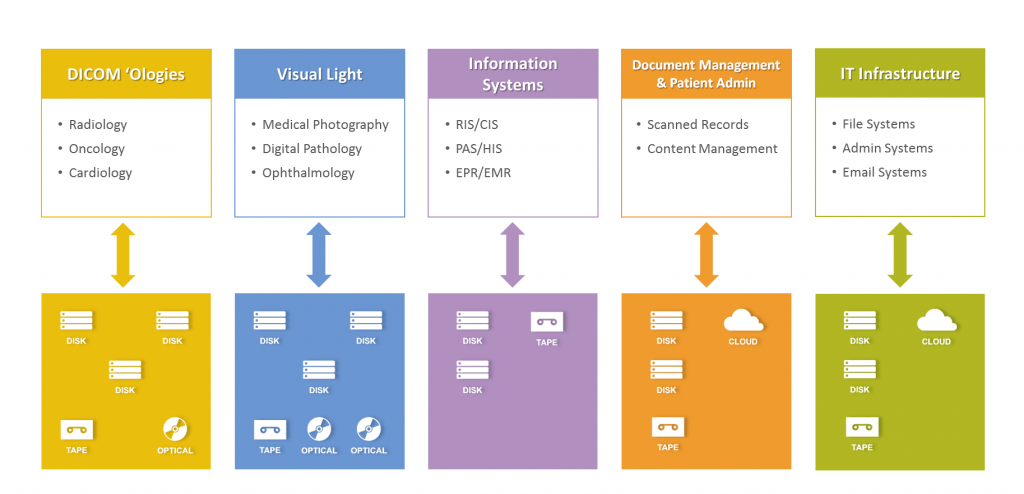By Jamie Clifton
With every healthcare solution we deliver, BridgeHead provides support or service to the provision of the Electronic Medical/Patient Record (EMR/EPR). The question is: why does the EMR need BridgeHead’s help or support?
As the EMR becomes ubiquitous, the challenge has shifted from merely digitizing patient information to managing that information more effectively so that the hospital realizes increased value from the data. One way of doing that is to extend the patient record to encompass all relevant data across the hospital system.
Organizations that have invested in the EMR don’t have a complete view of the patient record.
For example:
- 75% can access lab results, 25% cannot;
- 67% can access radiology reports, while 33% cannot – this is a really important figure since radiology reports are the easiest data to share;
- 51% can access patient consent information, while 49% cannot.
The list above only accounts for key data. The situation is worse for less organized data — such as mental health notes, ophthalmic data, sleep studies, ultrasound (usually kept on the modality only) or historic data of almost any kind, especially that on paper. In addition, legacy applications are a big and costly problem. While hospitals would like to retire these applications, they continue to pay six-figure annual licensing fees just to have access to the data.
 The diagram above demonstrates the fragmented and siloed nature of healthcare data.
The diagram above demonstrates the fragmented and siloed nature of healthcare data.
Compounding the fact that the EMR isn’t able to “consume” all the data in the hospital is the siloed nature of departmental applications. There are pushes to create a standard interface that enables the EMR to access content from the multiple applications that exist across the healthcare environment, but these are rarely implemented. Presently, when a hospital invests in an EMR, it’s really investing in multiple integrations into the myriad of systems creating all of the data that makes up the longitudinal patient record.
These multiple integrations are necessary to ensure that the EMR contains the most accurate and up-to-date information. However, this is neither an efficient nor cost-effective solution and is expensive for the hospital to maintain.
The fact is that most of the data that the EMR consumes isn’t real-time data or data created in the last few minutes. It’s data that is reference or legacy data that isn’t likely to change. BridgeHead HealthStore ™ provides more efficient access to this reference data while by creating a central repository for all of the patient’s healthcare data. It also provides the EMR with a single search interface for all legacy data and a far simpler and efficient integration to the majority of healthcare data.
How BridgeHead Solves the Problem
By simplifying the integration of all hospital data into an easily-accessed, standards-based data store, the BridgeHead HealthStore Independent Clinical Archive (ICA) makes it easier for hospitals to view, search and drive more value out of their healthcare data than ever before. It enables the EMR/EPR to be more efficient in a number of ways:
- Provides a single interface to allow the EMR to search all content types stored in the archive;
- Captures all hospital data using standard interfaces (DICOM, HL7, XDS and unstructured content), which can be used to capture new information or perform historic migrations;
- Maintains data quality, e.g. demographic updates;
- Ensures data is stored safely and efficiently and manages onward data migrations, so the EMR doesn’t have to.
With XDS at its core, HealthStore can ingest content in any format: DICOM, HL7 documents, native XDS documents and even unstructured content. As a result, primary applications need not be changed. For instance, to access the Radiology Information System (RIS), HealthStore integrates with HL7 to get the radiology reports, and then uploads the data to its central repository. Departmental applications can be migrated away from easily because HealthStore separates the application from the data and the data from the storage.
HealthStore dramatically improves access to all patient records by ensuring data is collected in a single repository and viewed via a simple Web-based tool. Because it’s designed from the ground up to manage healthcare data, the HealthStore ICA manages data for the long-term –safely, efficiently and securely. HealthStore is critical to healthcare organizations that are trying to standardize access to patient records in, for instance, a patient portal or frankly, in any holistic way that gives a complete view of the patients’ information
Find out more about BridgeHead HealthStore.



